 W
WThe Adoration of the Christ Child is a tempera and gold on panel painting by the Italian late medieval artist Gentile da Fabriano, dating from around 1420–1421 and housed in the Getty Center of Los Angeles, United States.
 W
WThe Adoration of the Magi is a tempera on panel painting by the Italian late Gothic artist Lorenzo Monaco, now housed in the Uffizi Gallery in Florence.
 W
WThe Altarpiece of Saints Ursula, Martin and Anthony is a reredo by the Spanish late Gothic painter Gonzalo Pérez, dating to 1420 and housed in the Museu de Belles Arts of Valencia, Spain.
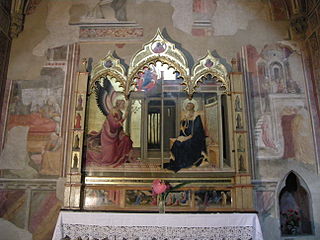 W
WThe Bartolini Salimbeni Annunciation is a painting by the Italian Gothic painter Lorenzo Monaco, completed just before his death (1420–1424) and housed in the Bartolini Salimbeni Chapel of the church of Santa Trinita, Florence, Italy.
 W
WThe Bartolini Salimbeni Chapel is a chapel in the church of Santa Trinita, Florence, central Italy. Its decoration by Lorenzo Monaco, dating to the 1420s, are one of the few surviving examples of International Gothic frescoes in Italy. The chapel has kept other original elements, such as its altarpiece, an Annunciation, also by Monaco, and the railings.
 W
WBeccuto Madonna is a c.1420-1425 fresco fragment by Paolo Uccello, now in the Museo nazionale di San Marco in Florence, Italy.
 W
WThe Brancacci Chapel is a chapel in the Church of Santa Maria del Carmine in Florence, central Italy. It is sometimes called the "Sistine Chapel of the early Renaissance" for its painting cycle, among the most famous and influential of the period. Construction of the chapel was commissioned by Felice Brancacci and begun in 1422. The paintings were executed over the years 1425 to 1427. Public access is currently gained via the neighbouring convent, designed by Brunelleschi. The church and the chapel are treated as separate places to visit and as such have different opening times and it is quite difficult to see the rest of the church from the chapel.
 W
WThe Carnesecchi Triptych was an altarpiece of c. 1423–1425 by Masolino, Masaccio and others, depicting the Madonna and Child with Saints Catherine of Alexandria and Julian the Hospitaller. It seems to mark the beginning of Masolino and Masaccio's collaboration.
 W
WCoronation of the Virgin is a c.1420 painting by Gentile da Fabriano, now in the Getty Museum. It originated as the front of the a processional banner - the reverse showed Saint Francis Receiving the Stigmata and is now in Parma.
 W
WThe Fiesole Altarpiece is a painting by the Italian early Renaissance master Fra Angelico, executed around 1424–1425. It is housed in the Convent of San Domenico, Fiesole, central Italy. The background was repainted by Lorenzo di Credi in 1501.
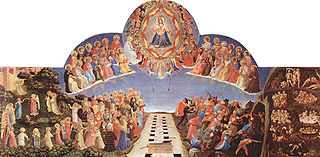 W
WThe Last Judgment is a painting by the Renaissance artist Fra Angelico. It was commissioned by the Camaldolese Order for the newly elected abbot, the humanist scholar Ambrogio Traversari. It is variously dated to c1425, 1425–30 and 1431. It was originally sited in the church of Santa Maria degli Angeli and now is in the museum of San Marco, Florence. It is not to be confused with another Fra Angelico Last Judgement in the Gemäldegalerie, Berlin.
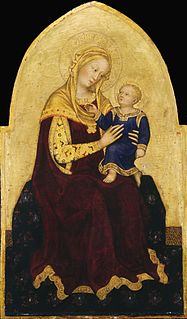 W
WMadonna and Child is a c.1420-1423 tempera and gold on panel painting by Gentile da Fabriano, now in the National Gallery of Art in Washington. The work is generally identified as one of the first the artist produced in Florence, where he had arrived in summer 1420, at roughly the point at which he was working on the Pala Strozzi. It may have been the central panel of a polyptych, the rest of which is now lost.
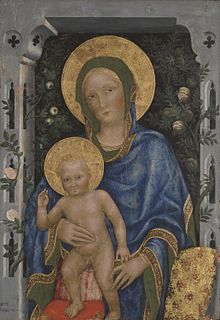 W
WMadonna and Child is a c.1424 tempera and gold on panel painting by Gentile da Fabriano, now in the Yale University Art Gallery in New Haven. It is signed on the left jamb "Gent / Fabriano". Previously traditionally dated to 1420-1423, the new accepted dating is based on similarities between the background architecture and the north door of the Florence Baptistery, completed by Lorenzo Ghiberti in 1424.
 W
WOrvieto Cathedral is a large 14th-century Roman Catholic cathedral dedicated to the Assumption of the Virgin Mary and situated in the town of Orvieto in Umbria, central Italy. Since 1986, the cathedral in Orvieto has been the episcopal seat of the former Diocese of Todi as well.
 W
WMadonna in the Church is a small oil panel by the early Netherlandish painter Jan van Eyck. Probably executed between c. 1438–40, it depicts the Virgin Mary holding the Child Jesus in a Gothic cathedral. Mary is presented as Queen of Heaven wearing a jewel-studded crown, cradling a playful child Christ who gazes at her and grips the neckline of her red dress in a manner that recalls the 13th-century Byzantine tradition of the Eleusa icon. Tracery in the arch at the rear of the nave contains wooden carvings depicting episodes from Mary's life, while a faux bois sculpture in a niche shows her holding the child in a similar pose. Erwin Panofsky sees the painting composed as if the main figures in the panel are intended to be the sculptures come to life. In a doorway to the right, two angels sing psalms from a hymn book. Like other Byzantine depictions of the Madonna, van Eyck depicts a monumental Mary, unrealistically large compared to her surroundings. The panel contains closely observed beams of light flooding through the cathedral's windows. It illuminates the interior before culminating in two pools on the floor. The light has symbolic significance, alluding simultaneously to Mary's virginal purity and God's ethereal presence.
 W
WThe Madonna of Humility is a tempera-on-panel painting by the Italian late medieval artist Gentile da Fabriano, dating from around 1420-1423 and housed in the Museo nazionale di San Matteo, Pisa.
 W
WThe Madonna of the Quail is an International Gothic painting generally attributed to Pisanello. Dating to c. 1420, it was housed in the Castelvecchio Museum of Verona, northern Italy until stolen in 2015.
 W
WThe Marriage of the Virgin or also known as The Betrothal of the Virgin, is a c.1420-1430 oil on oak painting by Robert Campin. The painting was intended to be a metaphor, primarily focused on the transition from the Old to the New Testament, which is expressed through iconography and disguised symbolism. It entered into the Spanish royal collection at El Escorial in 1584. It was later obtained by Prado Museum, where it continues to reside. This work by Robert Campin is one of his earliest and was previously attributed to Roger Van der Weyden. The work presents the betrothing of Mary and Joseph in front of an incomplete Gothic portal. In the left background, there is a Romanesque building that presents the Miracle of the Flowering Rod. This is the event in which Joseph was chosen to be wed to Mary. Presented at the top of the building are stain glassed windows which depict scenes from the Hebrew Bible thought to be Old Testament stories, such as Abraham's sacrifice of Isaac. The overall objective of Robert Campins "Marriage of the Virgin" was to symbolize the transition of Old Dispensation to the New Dispensation.
 W
WThe Mérode Altarpiece is an oil on oak panel triptych, now in The Cloisters, in New York City. It is unsigned and undated, but attributed to Early Netherlandish painter Robert Campin and an assistant. The three panels represent, from left to right, the donors kneeling in prayer in a garden, the moment of the Annunciation to Mary, which is set in a contemporary, domestic setting, and Saint Joseph, a carpenter with the tools of his trade. The many elements of religious symbolism include the lily and fountain, and the Holy Spirit represented by the rays of light coming through from the left hand window.
 W
WThe Mystical Marriage of Saint Catherine is a painting by the medieval Italian painter Michelino da Besozzo. The painting dates from c. 1420 and is housed in the Pinacoteca Nazionale of Siena, Italy.
 W
WNativity is a 1420 panel painting by the Early Netherlandish painter Robert Campin. As often, the moment shown is the adoration of the shepherds. Harshly realistic, the Child Jesus and his parents are shown in poverty, the figures crowded in a small structure, with broken-down walls, and a thatched roof with a hole, the single space shared with animals. In this Campin abandons the traditional narrative.
 W
WPortrait of a Fat Man are names given to two near-identical oil on panel paintings attributed to the Early Netherlandish artist Robert Campin. Both versions are dated c. 1425, and are in the Gemäldegalerie, Berlin and Museo Thyssen-Bornemisza, Madrid.
 W
WThe Adoration of the Magi is a painting by the Italian painter Gentile da Fabriano. The work, housed in the Uffizi Gallery in Florence, Italy, is considered his finest work, and has been described as "the culminating work of International Gothic painting".
 W
WSaint Francis Receiving the Stigmata is a c.1420 oil and tempera painting by Gentile da Fabriano, now in the Magnani-Rocca Foundation in the Province of Parma in Italy. It is the back of a processional banner - the front showing the Coronation of the Virgin is now in the Getty Center in Los Angeles.
 W
WThe St. Peter of Verona Triptych is a painting by the Italian early Renaissance master Fra Angelico, executed around 1428–1429. It is housed in the National Museum of San Marco, Florence, region of Tuscany, Italy.
 W
WThe Tribute Money is a fresco by the Italian Early Renaissance painter Masaccio, located in the Brancacci Chapel of the basilica of Santa Maria del Carmine, Florence. Painted in the 1420s, it is widely considered among Masaccio's best work, and a vital part of the development of renaissance art.
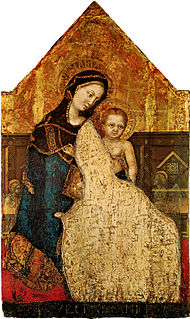 W
WThe Velletri Madonna is a c.1426-1427 tempera and gold on panel painting by Gentile da Fabriano, the only surviving work from his stay in Rome. Of the Madonna of humility type, it was in the church of Santi Cosma e Damiano until 1633 when Ludovico Ciotti di San Paolo, General of the Third Order Franciscans, donated it to the church of Sant'Apollonia in Velletri. It is now in the Diocesan Museum in Velletri. A restoration in 1912 restored the top to its original triangular form.
 W
WThe Master of the Wasservass Calvary is the notname for a painter active in Cologne between 1415 and 1435. He is relatively unusual in Cologne art of his time, owing more to Burgundian manuscript illuminating and Early Netherlandish painting of the time.